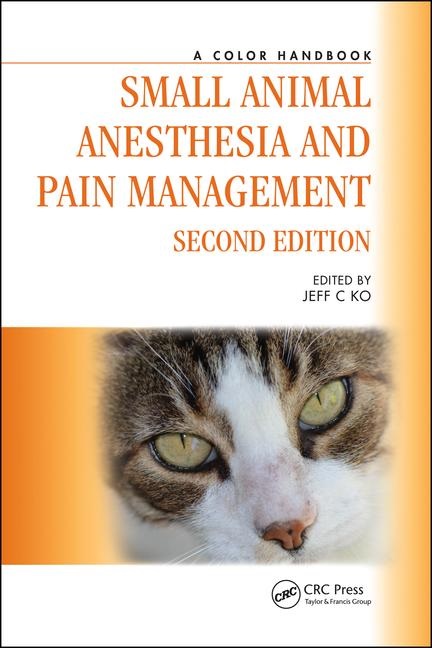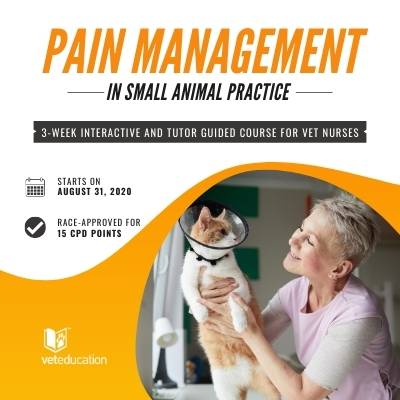Small Animal Regional Anesthesia and Analgesia Book Reviews

Book Championship: Small Animate being Anesthesia and Pain Management: A Color Handbook. 2nd Edition
Edited by: Jeff C Ko
Publisher: CRC Press
ISBN-13: 978-1-138-03568-iii
Number of pages: 448
Reviewed past: Dr. Philip Judge
The subject of analgesia and anaesthesia in pocket-sized animal do remains critical to ensuring the health and wellbeing of dogs and cats in veterinary care. This is fabricated more important as we feel advances in our understanding of the physiology of pain, drug pharmacology, and the development of novel pharmaceutical agents used in analgesia and anesthesia.
The book "Small Fauna Anesthesia and Hurting Management: A Color Handbook" is designed with practicing clinicians in mind, offering a concise, "quick-reference" access to core updates and essentials related to the book title.
The book is authored past 20 veterinarians, most of whom are specialists in anesthesia, analgesia, concrete rehabilitation, emergency and critical care, radiation oncology and internal medicine.
The book begins with a detailed description of the inhalant anesthesia, including equipment selection and maintenance, circuit choice, oxygen menstruation rates, and inhalant pharmacokinetics. Enhanced with numerous photographs, this section is ideal for any veterinary staff member wanting a thorough description on the use of inhalational anesthesia.
The section on pre-operative claret tests and urine analysis follows, which is a basic summary, and actually serves as a refresher, rather than a comprehensive reference on available tests. For example, some laboratory tests such as pancreatic lipase immunoreactivity assays are not mentioned at all.
The following chapter on pre-coldhearted medications presents the near common medications used. The format is curtailed, and includes full general drug features, advantages/disadvantages, and doses; and is followed by a chapter on intravenous consecration agents, including injection techniques, and another chapter on the techniques and agents used in inhalant anaesthesia. The section on anesthesia monitoring is first-class, and includes detailed descriptions of respiratory, cardiovascular and neurological monitoring.
The first office of the volume continues with chapters on fluid therapy, claret competent/transfusion therapy, the use of drug combinations used for sedation-analgesia-anesthesia – specifically those combinations using alpha-2 agonists, along with a description of the pre-formulated combination tiletamine-zolazepam in combination with opioids or alpha-2 agonists.
There follows a very useful introduction to anaesthetic considerations for specific diseases, including hepatic, cardiac, respiratory, CNS, endocrine, urinary, gastrointestinal, cesarean and trauma patients. These organ systems are significantly expanded in subsequent chapters, to include more detailed physiology, and patient and pharmacological considerations, along with some useful example anesthetic protocols for each organ system disorder.
The last one/3 of the book is devoted to analgesic techniques and pharmacology in the dog and cat, and includes some fantabulous chapters on local anesthesia, acute pain direction, chronic pain management, and analgesia for the oncology patient. The book concludes with some interesting chapters on acupuncture, Chinese medicine, rehabilitation, euthanasia and shelter medicine anesthesia.
The text is easy to read, with articulate headings and sub-headings, and the straightforward text presented in bullet-points, for added clarity. There are likewise numerous high-quality original photographs and diagrams contained throughout the book, which serve to illustrate key aspects of the text.
Whilst in that location is a lot of useful information independent in the book, additional searching is needed to find some items e.m. FLK continuous infusion clarification is only included in the section on analgesia for orthopedic patients, and not elsewhere in the book. A larger section on drug doses, with the inclusion of formula and instructions for continuous infusions at the finish of the book, for ease of accessing this data for the busy practitioner would besides be a welcome improver. These, however, are modest criticisms of what is overall a very good reference. Despite being a handbook, the depth of information provided in many areas of this book should be meaning enough to satisfy a wide range of readers – from technicians and nurses, through to veterinarian students, general practitioners, and referral and emergency clinicians. Those requiring in-depth content on physiology, pharmacokinetics and dynamics, volition, however, find some shortcomings in this reference. However, equally a quick reference guide for both students and veterinary practitioners, this book nails its brief very well.
Don't miss this heady 3-week class!

ThePain Management in Small Animal Do course brings y'all an opportunity to learn new skills and make the most of your fourth dimension at home.
The course will journey through the physiology of hurting perception, how different analgesics work, how to accurately monitor patients on analgesic therapy. What's more, we will too review specific analgesic techniques in various diseases and procedures, including emergency analgesia of the critically ill patient, and much more.
This interactive and tutor guided course for Veterinary Nurses & Technicians isRACE-approved for fifteen CPD points and starts onAugust 31, 2020.
Source: https://veteducation.com.au/book-review-small-animal-anesthesia-pain-management/
Post a Comment for "Small Animal Regional Anesthesia and Analgesia Book Reviews"